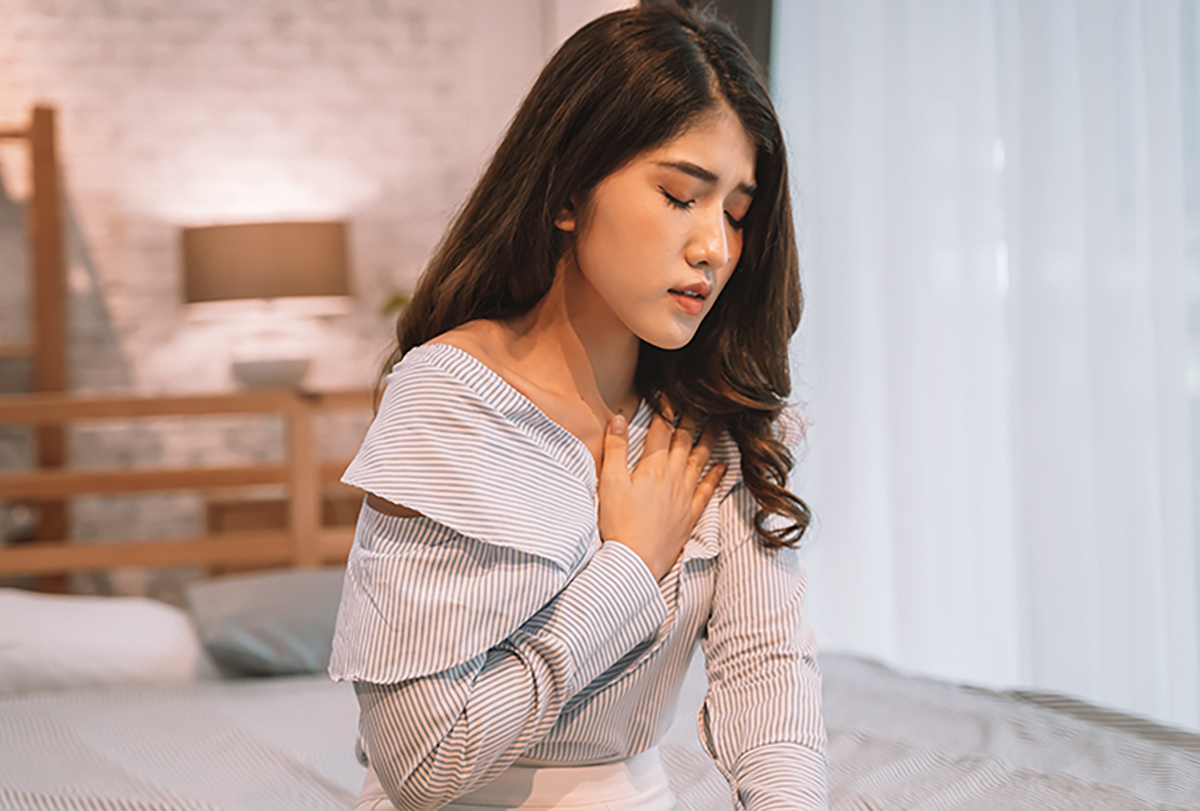In this article:
Orthopnea is the sensation of having difficulty breathing when lying down flat, which tends to resolve when you stand or your head is elevated above your feet. (1) It usually occurs when you fall asleep at night or while lying down.

Sleeping with your head in a raised position can make it go away. You can do so by propping a few extra pillows under your head, using slanting mattresses or a bed with raised head, or sleeping in a chair, although that may prove uncomfortable in the long run. (2)
The idea is to raise your upper body above the feet so that the natural force of gravity can push down the fluid and prevent it from accumulating in the chest.
Causes of Orthopnea
Orthopnea can be the result of any of the following conditions:
1. Fluid retention in the lungs
Orthopnea mostly occurs due to fluid retention in the lungs, which is usually triggered by underlying heart failure.
Diminished heart function or heart valve disease causes excess fluid to back up and be retained in the lungs. This makes it extremely difficult for the oxygen released by your lungs to pass into the bloodstream. (3) The lack of oxygenated blood to the organs, in turn, makes it difficult to breathe.
However, the feeling resolves when you stand up or elevate your upper body above the feet, as the downward pull of gravity redistributes the fluid in your lungs, making it easier to absorb oxygen into your bloodstream.
2. Compression of the lungs
Compression of your lungs can also diminish their function and cause labored breathing.
3. Additional causes
Additional causes include altitude sickness, lung disease, obesity, abdominal swelling from the fluid (ascites), and paralysis of the nerve that leads to the diaphragm (phrenic nerve). (4)
Medical Treatment for Orthopnea
The medical treatment for orthopnea depends on its underlying cause:
- Heart failure is generally treated with medication including diuretics, (5) angiotensin-converting enzyme (ACE) inhibitors, and beta-blockers. Separate interventions are recommended depending on whether heart failure was caused by valvular or non-valvular heart disease. (6)
- Valvular heart disease often requires surgery or catheter-based valve repair or replacement.
- Coronary artery disease can also cause heart failure, which may require stents or bypass surgery.
- Lung diseases such as COPD can be treated with bronchodilators, oxygen therapy, and steroids. (7)
Diagnosing Orthopnea

If you regularly experience unexplained shortness of breath while lying down, you must visit a doctor to get a proper diagnosis and treatment.
The doctor will first review your medical history and symptoms and then conduct a physical examination, which may include checking for chest sounds through a stethoscope.
If this initial investigation is inconclusive, you may have to undergo a few additional tests such as:
- Chest X-ray to evaluate the lungs for extra fluid or lung compression
- Ultrasound of the heart (echocardiogram) to visualize heart abnormalities, including poor function and heart valve problems
- Electrocardiogram (EKG) to identify heart rate or rhythm abnormalities or evidence of a current or prior heart attack
- Cardiac stress test to identify atherosclerotic heart disease
- Blood tests to detect various body function failures that can cause extra fluid in the lungs or a low blood count
- Lung function studies to identify chronic obstructive lung disease, such as chronic obstructive pulmonary disease (COPD) and emphysema, usually caused by smoking
Further testing may be indicated based on the results of these tests. Such tests include cardiac catheterization with a coronary angiogram, Holter monitor test, and bronchoscopy.
Lifestyle Changes or Self-Care Measures

Here are a few tips to ease and prevent orthopnea and are especially recommended for high-risk individuals:
- Manage your blood pressure
- Keep your blood sugar within the normal range
- Consume a healthy diet
- Exercise regularly
- Maintain healthy body weight
- Stop smoking
Who Are at Risk?
People who are at risk for heart and lung disease are also more likely to develop orthopnea. (8) These include:
- Smokers
- People with a family history of heart disease and stroke
- People with high blood pressure, diabetes, or high cholesterol levels
- People who are overweight
When to See a Doctor
You should see a doctor with the onset of orthopnea. Chronic orthopnea with worsening symptoms warrants prompt evaluation by a physician.
Final Word
Orthopnea is a symptom of difficulty breathing when lying down. This usually requires evaluation by your doctor. Further testing is designed to elucidate the cause of this symptom.
Causes include heart disease, lung disease, abdominal swelling, obesity, and nerve paralysis. The treatment can include medications, invasive procedures, and/or surgery.
- Was this article helpful?
- YES, THANKS!NOT REALLY


